Power electronic handbook
Подождите немного. Документ загружается.

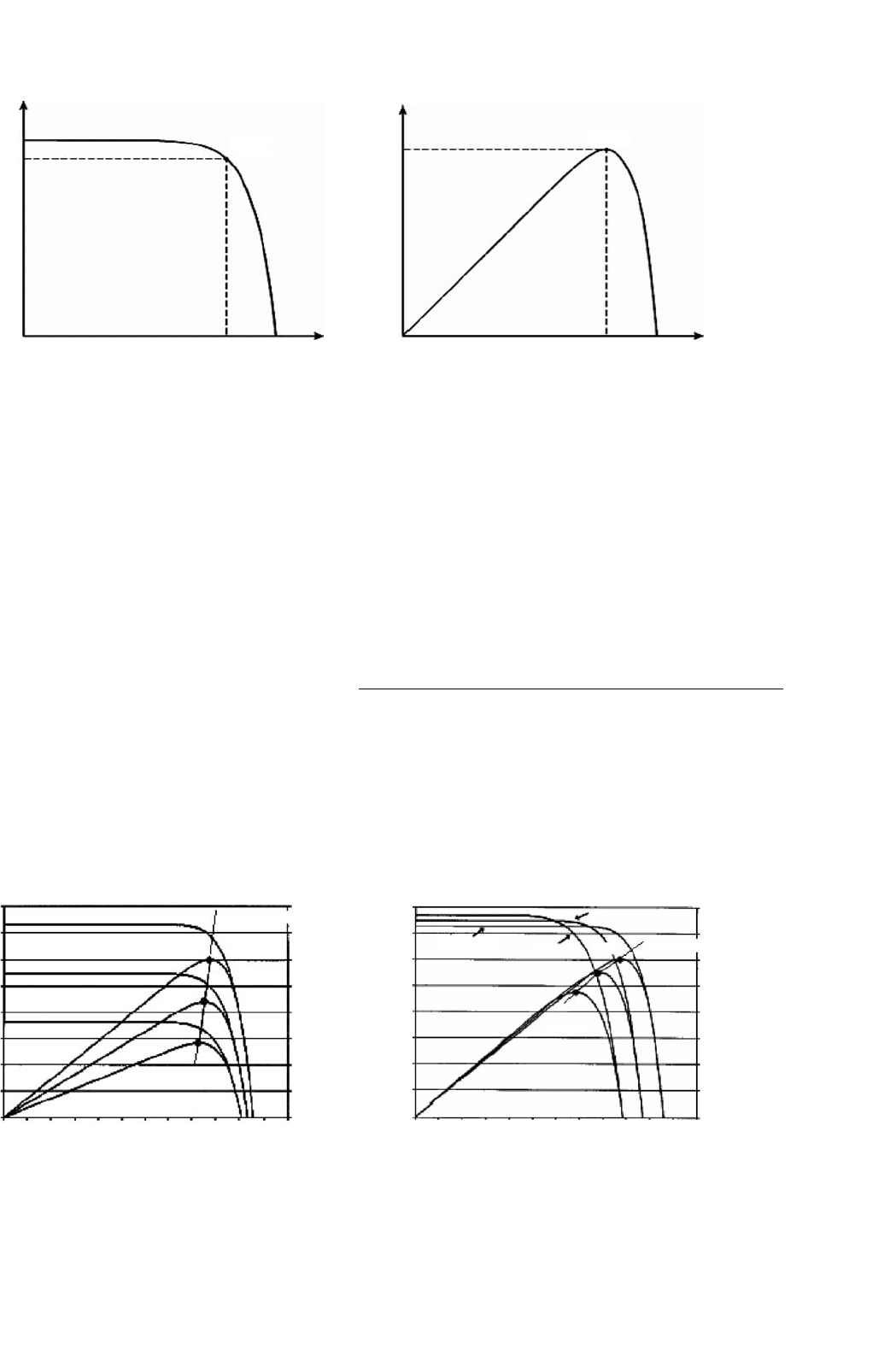
664 L. Chaar
Voltage
(a)
MPP
I
mpp
Current
V
mpp
Voltage
(b)
MPP
p
mpp
Power
V
mpp
FIGURE 26.6 (a) I–V characteristics of a solar cell showing maximum power point (MPP) and (b) P–V characteristics showing MPP.
a certain level of temperature and insolation. The I–V curve
changes as the temperature and insolation levels change as
shown in Fig. 26.7, thus the MPP will vary accordingly [9].
It has shown that the open circuit voltage increases log-
arithmically while the short circuit increases linearly as the
insolation level increases [10]. Moreover, increasing the cell’s
temperature decreases the open circuit voltage and increases
slightly the short circuit current. This then makes the cell less
efficient.
Since solar power is relatively expensive, it is important to
operate panels at their maximum power conditions. Thus,
PV systems will operate more efficiently with systems that
can adjust automatically their loads to match the PV resis-
tance. In addition, panels would change orientation to track
the sun.
We need then to control either the operating voltage or the
current to get maximum power from the PV panel at the pre-
vailing temperature and insolation conditions using maximum
4
3.5
3
I-V 0.75 kWm
2
MPP
MPP
max power line
max power line
Power
Power
I-V 0.5 kWm
2
I-V 1 kWm
2
I-V 25 εC
I-V 75εC
I-V 50εC
2.5
2
1.5
1
0.5
0
80
70
60
50
40
30
20
10
0
Voltage (V)
Current (A)
Power (W)
(a)
0 2 4 6 8 10 12 14 16 18 20 22 24
4
3.5
3
2.5
2
1.5
1
0.5
0
80
70
60
50
40
30
20
10
0
Voltage (V)
Current (A)
Power (W)
(b)
0 2 4 6 8 10 12 14 16 18 20 22 24
FIGURE 26.7 (a) PV panel insolation characteristics and (b) PV panel temperature characteristics [9].
power point tracker (MPPT) which should meet the following
conditions [11]:
• Operate the PV system as close as possible to the MPP
irrespective of the atmospheric changes.
• Have low cost and high conversion efficiency.
•
Provide an output interface compatible with the battery-
charging requirement.
26.4 Maximum Power Tracker
The MPPT maximizes the energy that can be transferred
from the array to an electrical system. Its main function is
to adjust the panel output voltage to a value at which the
panel supplies the maximum energy to the load. Most cur-
rent designs consist of three basic components: a switch-mode
dc–dc converter, a control, and tracking section.
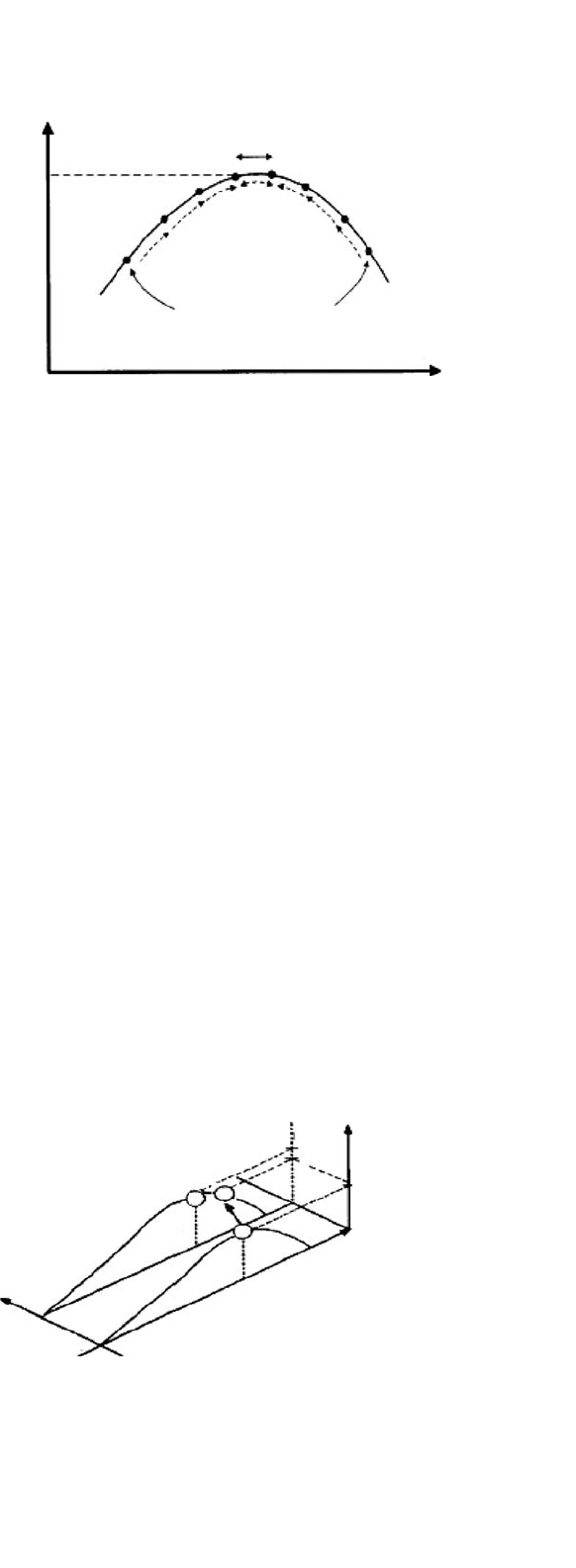
26 Solar Power Conversion 665
26.4.1 Switch-mode Converter
The switch-mode converter is the core of the entire supply.
It allows energy at one potential to be drawn, stored as mag-
netic energy in an inductor, and then released at a different
potential. By setting up the switch-mode section in various
different topologies, either high-to-low (Buck converter) or
low-to-high (Boost converter), voltage converters can then be
built. The main goal is to provide a fixed input voltage and/or
current, such that the array is held at the maximum power
point, while allowing the output to match the battery.
26.4.2 Controller
The controller should keep testing if the PV system is operating
at the PV maximum power point. It should force the system
to track this MPP. Continuous measuring of the voltage and
current from the PV array, and then performing either voltage
or power feedback control [12] is the method used.
26.4.2.1 Voltage Feedback Control
The control variable here is the PV array terminal voltage.
The controller forces the PV array to operate at its MPP by
changing the array terminal voltage. It neglects, however, the
variation in the temperature and insolation level [12, 13].
26.4.2.2 Power Feedback Control
The control variable here is the power delivered to the load.
To achieve maximum power the quantity dp/dv is forced to
zero. This control scheme is not affected by the characteristics
of the PV array, yet it maximizes power to the load and not
power from the PV array [12, 13].
Fast shadows cause trackers to lose the MPP momentar-
ily, and the time lost in seeking it again, because the point has
moved away quickly and then moved back to the original posi-
tion, equating to the energy lost while the array is off power
point. On the other hand, if lighting conditions do change,
the tracker needs to respond within a short amount of time to
the change to avoid energy loss. Thus the controller should be
capable of adjusting and keeping the PV at its MPPT.
Several algorithms were proposed to accomplish MPPT
controller. Published MPPT methods include: (1) Perturb
and Observe (PAO) [14], (2) Incremental Conductance Tech-
nique (ICT) [14], and (3) Constant Reference Voltage/Current
[11, 14].
26.4.3 MPPT Controller Algorithm
26.4.3.1 Perturb and Observe (PAO)
The Perturb and Observe method has a simple feedback struc-
ture and few measured parameters. It operates by periodically
perturbing (i.e. incrementing or decrementing) the duty cycle
PV output
power
MPP
Steady-state operation
Possible starting points
Dut
y
c
y
cle
FIGURE 26.8 PAO technique [11].
controlling the array current as shown in Fig. 26.8 and compar-
ing the PV output power with that of the previous perturbation
cycle. If the perturbation leads to an increase (or decrease) in
array power, the subsequent perturbation is made in the same
(or opposite) direction. In this manner, the peak power tracker
continuously seeks the peak power condition.
The PAO technique is easy to implement and costs the least
among the other available techniques. It is considered to be
a very efficient scheme in terms of power being extracted
from the PV array [15]. However the PAO technique will
be confused in catching the MPP under rapid varying solar
radiation [14]. If the Insolation level increases (I
2
> I
1
) then
the controller will assume that the incremental step should
keep moving in the same direction toward point ② when the
new MPP is really in the other direction at point ③ as shown
in Fig. 26.9 [14]. So for the PAO algorithm, the power has
increased because the new MPP is toward the right whereas it
has already been passed to point ③. In the following pertur-
bation the PAO algorithm will increment the array operating
voltage further right, point ②. In this way the PAO algorithm
will continue to deviate from the actual MPP, with a corre-
sponding power loss, until the solar radiation change slows or
settles down [14].
Voltage
Power
P
max
(I
2
)
P
2
3
2
1
I
2
I
1
Insolation
P
1
= P
max
(I
2
)
FIGURE 26.9 Deviation of the PAO technique from the MPP [14].
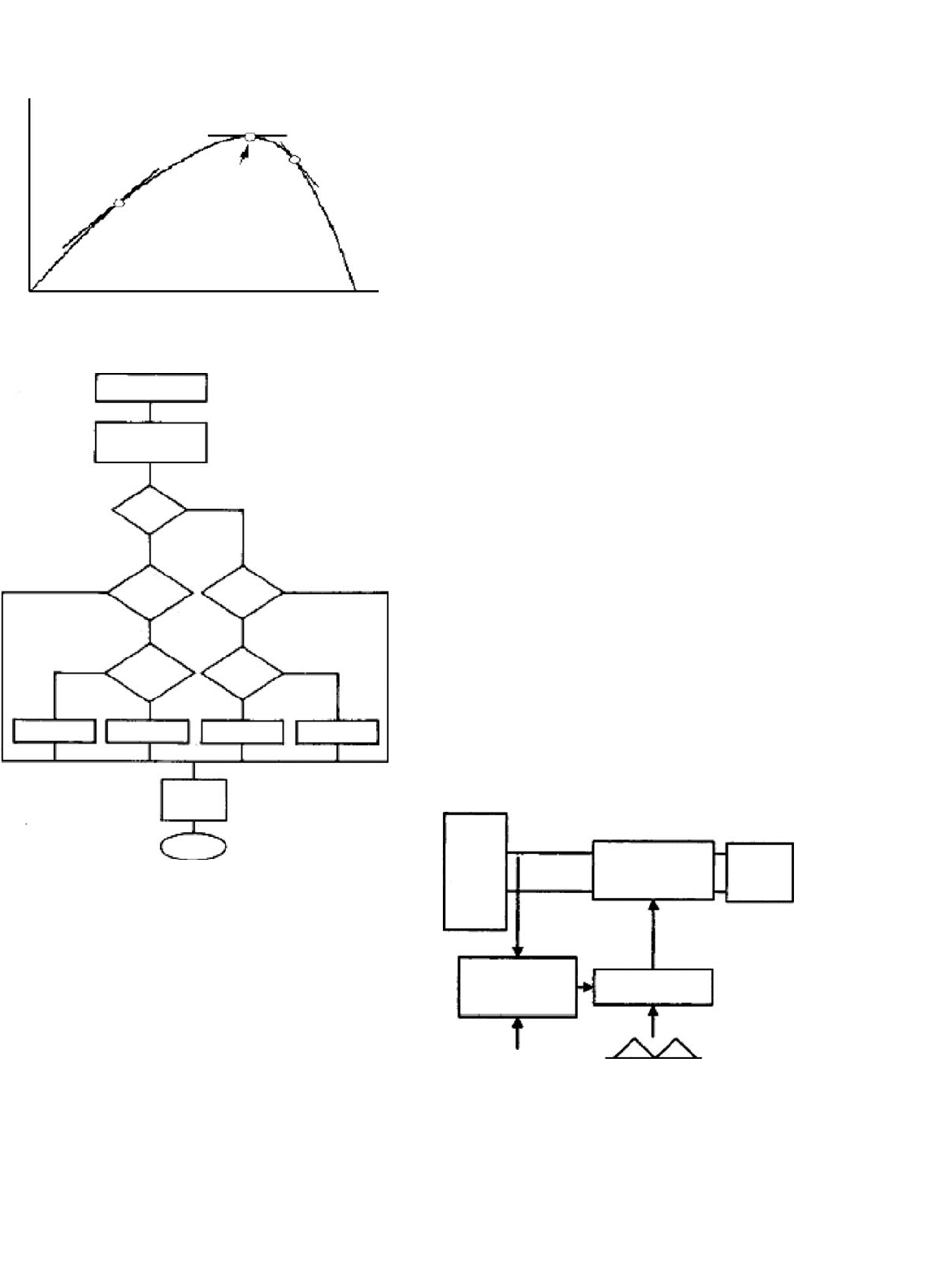
666 L. Chaar
dp/dv<0
dp/dv >0
P
V
dp/dv = 0
MPP
FIGURE 26.10 The slope “conductance” of the P–V curve [16].
dI:= I
n
−I
b
dV:= V
n
−V
b
input: V
n
·I
n
V
r
=V
r
+∆VV
r
=V
r
−∆V
V
b
=V
n
I
b
=I
n
return
V
r
=V
r
−∆VV
r
=V
r
+∆V
dI/dV= −I/V
?
dI/dV>−I/V
?
dI=0
?
dI>0
?
dV=0
?
no
no
no no
no
yes
yes
yes
yes
yes
FIGURE 26.11 Flow chart of the ICT algorithm [14].
26.4.3.2 Incremental Conductance Technique (ICT)
The basic idea is that the derivative of the power with respect
to the voltage (dp/dv) vanishes at the MPP since it is the
maximum point on the curve as shown in Fig. 26.10.
The ICT algorithm checks for MPP by comparing dI/dV
against −I/V till it reaches the voltage operating point at
which the incremental conductance is equal to the source con-
ductance [14, 17]. The flow chart for the ICT algorithm is
described in Fig. 26.11.
The algorithm starts by obtaining the present values of I
and V, then using the corresponding values stored at the end
of the preceding cycle, I
b
and V
b
, the incremental changes are
approximated as: dI = I–I
b
, and dV = V − V
b
and according
to the result of this check, the control reference signal V
ref
will be adjusted in order to move the array voltage toward the
MPP voltage. At the MPP, dI /dV =−I/V , no control action
is needed, therefore the adjustment stage will be bypassed and
the algorithm will update the stored parameters at the end of
the cycle as usual. Another check is included in the algorithm
to detect whether a control action is required when the array
was operating at the previous cycle MPP (dV = 0); in this
case the change in weather condition will be detected using
(dI = 0) [14].
This technique offers good performance under varying
atmospheric conditions contrary to the PAO technique. How-
ever it requires complete mathematical model for the topology
used and its complex circuitry adds to the cost of the MPPT
controller [16].
26.4.3.3 Constant Reference Voltage
One very common MPPT technique is to compare the PV
array voltage (or current) with a constant reference voltage (or
current), which corresponds to the PV voltage (or current) at
the maximum power point, under specific atmospheric con-
ditions as shown in Fig. 26.12. The resulting difference signal
(error signal) is used to drive a power conditioner, which inter-
faces the PV array to the load. Although the implementation
of this method is simple, the method itself is not very accurate,
since it does not take into account the effects of temperature
and irradiation variations [11].
26.4.3.4 Other Techniques
Other techniques exist such as current-based maximum power
point tracker “CMPPT” and voltage-based maximum power
PV
array
Power
conditioner
Load
Comparator
Error
amplifier
Voltage
or current
reference
Array
voltage
or
current
FIGURE 26.12 MPPT control system with constant voltage
reference [11].
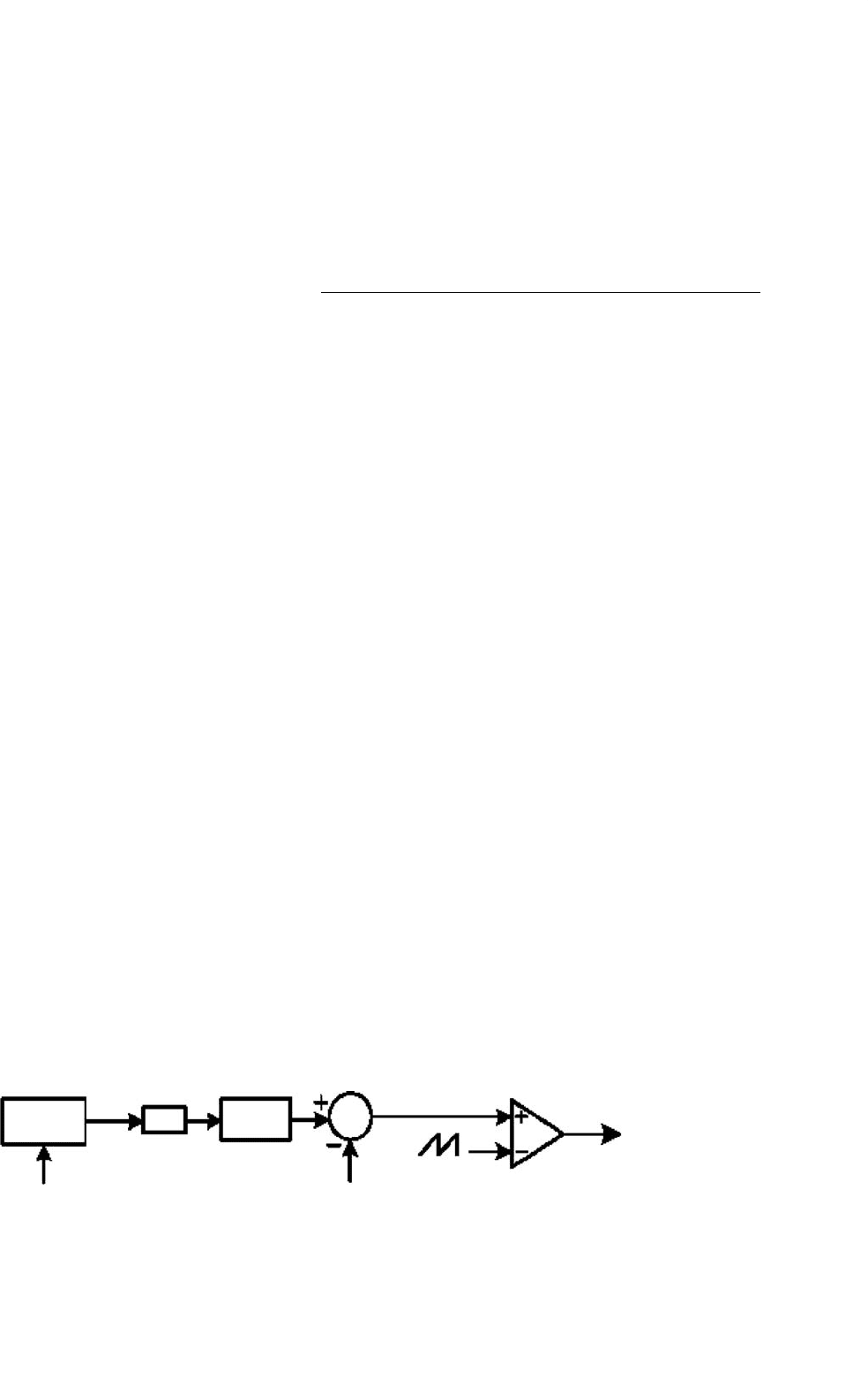
26 Solar Power Conversion 667
point tracker “VMPPT” [16]. Employed numerical methods
show a linear dependence between the “cell currents cor-
responding to maximum power” and the “cell-short circuit
currents”. The current I
MPP
operating at the MPP is calculated
using the following equation:
I
MPP
= M
C
I
SC
(26.3)
where M
C
is called the “current factor”. This factor M
C
differs
from one panel to another and is affected by the panel surface
conditions, especially if partial shading covers the panel [18].
Similarly the MPP operating voltage is calculated directly
from V
OC
:
V
MPP
= M
V
V
OC
(26.4)
where M
V
is the “voltage factor”.
The open circuit voltage V
OC
is sampled by analog sam-
pler, and then V
MPP
is calculated by Eq. (26.4). This operating
V
MPP
voltage is the reference voltage for the voltage control
loop as shown in Fig. 26.13. This method always, “results in a
considerable power error because the output voltage of the PV
module only follows the unchanged reference voltage during
one sampling period” [19].
Others argue that these two techniques are considered to
be “fast, practical, and powerful methods for MPP estima-
tion of PV generators under all insolation and temperature
conditions” [21].
26.4.3.5 Comparative Study
A comprehensive experimental comparison between different
MPPT algorithms was prepared at South Dakota State Univer-
sity [22]. After presenting the advantages and disadvantages of
each algorithm, an experiment for the same PV array setup was
run. Results showed that the ICT method has the highest effi-
ciency (98%) in terms of power extracted from the PV array,
next is the PAO technique efficiency (96.5%), and finally the
Constant Voltage method efficiency (88%).
The ICT method offers good performance under rapidly
changing weather conditions and seems to provide the high-
est tracking efficiency, however four sensors are required to
perform the measurements for computations and decision
making [14]. If the system requires more conversion time in
V
PV
V
oc
V
smp
V
*
V
*
q
1
K
1
Σ
Sampler
Hold
circuit
Sawtooth
FIGURE 26.13 The conventional MPPT controller using open circuit voltage V
oc
[20].
tracking the MPP, a large amount of power loss will occur [12].
On the contrary, if the sampling and execution speed of the
perturbation and observation method is increased, then the
system loss will be reduced. This technique requires only two
sensors. This results in the reduction of hardware requirement
and cost.
26.5 Photovoltaic Systems’ Components
Once the PV array is controlled to perform efficiently, a
number of other components are required to control, con-
vert, distribute, and store the energy produced by the array.
Such components may vary depending on the functional and
operational requirements of the system. They may require
battery banks and controller, dc–ac inverters, in addition to
other components such as overcurrent, surge protection and
other processing equipment. Figure. 26.14 shows a basic dia-
gram of a photovoltaic system and the relationship with each
component.
Photovoltaic systems are classified into two major classes:
utility grid-connected photovoltaic systems and stand-alone
photovoltaic systems.
26.5.1 Grid-connected Photovoltaic System
Grid-connected photovoltaic systems are designed to operate
in parallel with the electric utility grid as shown. There are
two general types of electrical designs for PV power systems:
systems that interact with the utility power grid as shown in
Fig. 26.15a and have no battery backup capability, and systems
that interact and include battery backup as well, as shown
in Fig. 26.15b. The latter type of system incorporates energy
storage in the form of a battery to keep “critical load” circuits
operating during utility outage. When an outage occurs, the
unit disconnects from the utility and powers specific circuits
of the load. If the outage occurs in daylight, the PV array is
able to assist the load in supplying the loads.
The major component in both systems is the dc–ac
inverter or also called the power conditioning system (PCS).
Figure 26.16 shows the block diagram of such connection.
The inverter, used to convert photovoltaic dc energy to ac
energy, is the key to the successful operation of the system,
but it is also the most complex hardware. The most important
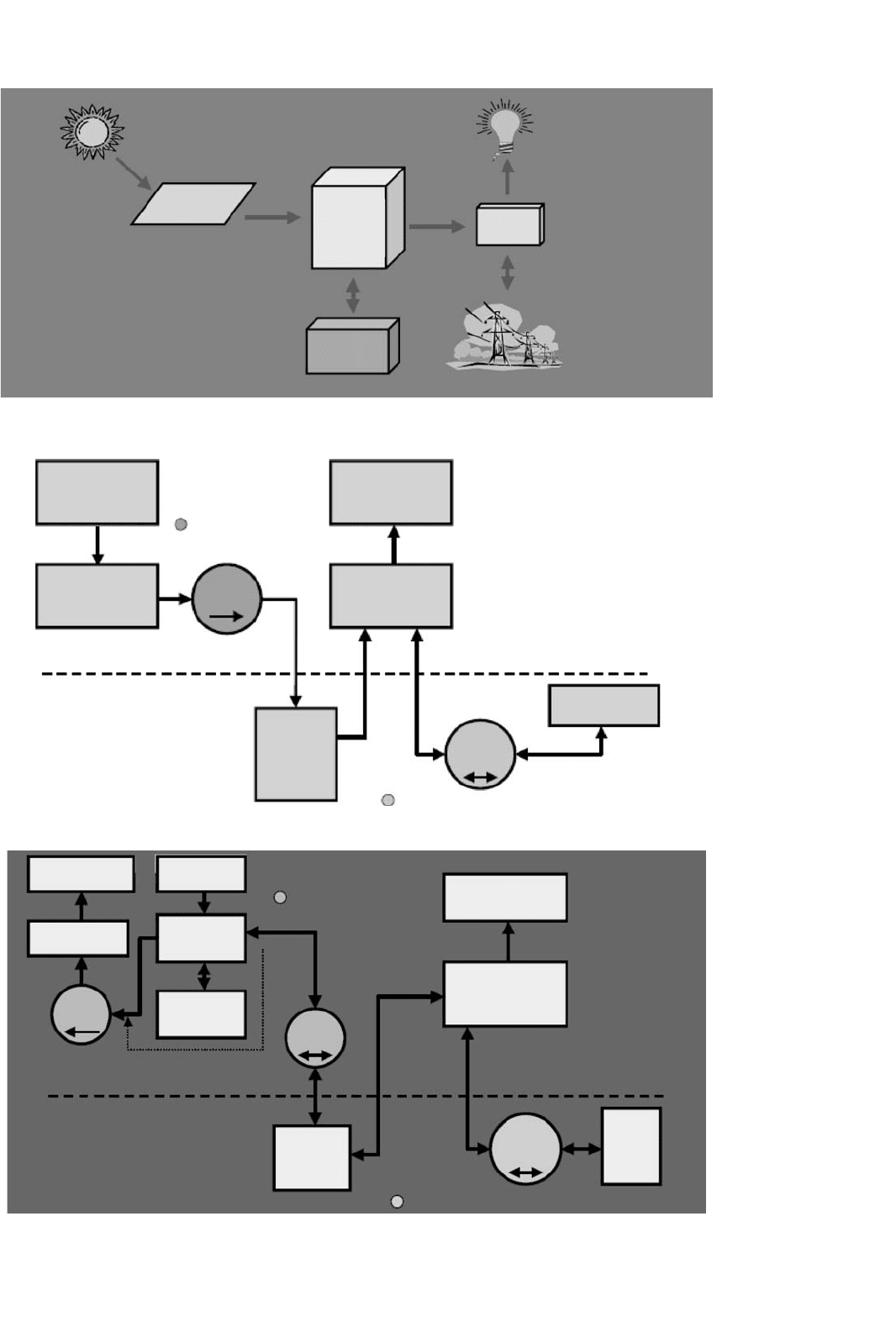
Energy
source
Power
conditioning
Load
utilization
Energy
distribution
Electric
utility
network
Energy
storage
Energy
conversion
PV array
Inverter
charger
controller
Load
center
Battery
FIGURE 26.14 Major photovoltaic system components [6].
(a)
(b)
PV array
Customer
electrical loads
Customer
electrical
panel
Inverter
Customer
Outdoor
disconnect
Utility
net kWh
Electric utility
network
Utility
Customer-supplied visible break,
lockable PV disconnect
(utility may require)
Customer-supplied meter
for PV generation
(recommended)
*Arrows indicate directions of power flows
*Arrows indicate directions of power flows
Standard, bi-directional revenue meter (utility-supplied)
PV kWh
Customer
backup load
PV array
Customer
sub panel
Inverter/
charger
Battery
storage
Inverter bypass circuit
transfer switch
Customer
main electrical
panel
Customer primary
electrical load
Electric
utility
network
Utility net
kWh
Outdoor
disconnect
Visible break,
lockable PV disconnect
Utility
Customer
Standard, bi-directional revenue meter (utility-supplied)
PV system
sub metering
From
main kWh
From
main kWh
FIGURE 26.15 Grid-connected PV system: (a) without battery back-up [23] and (b) with battery storage [23].
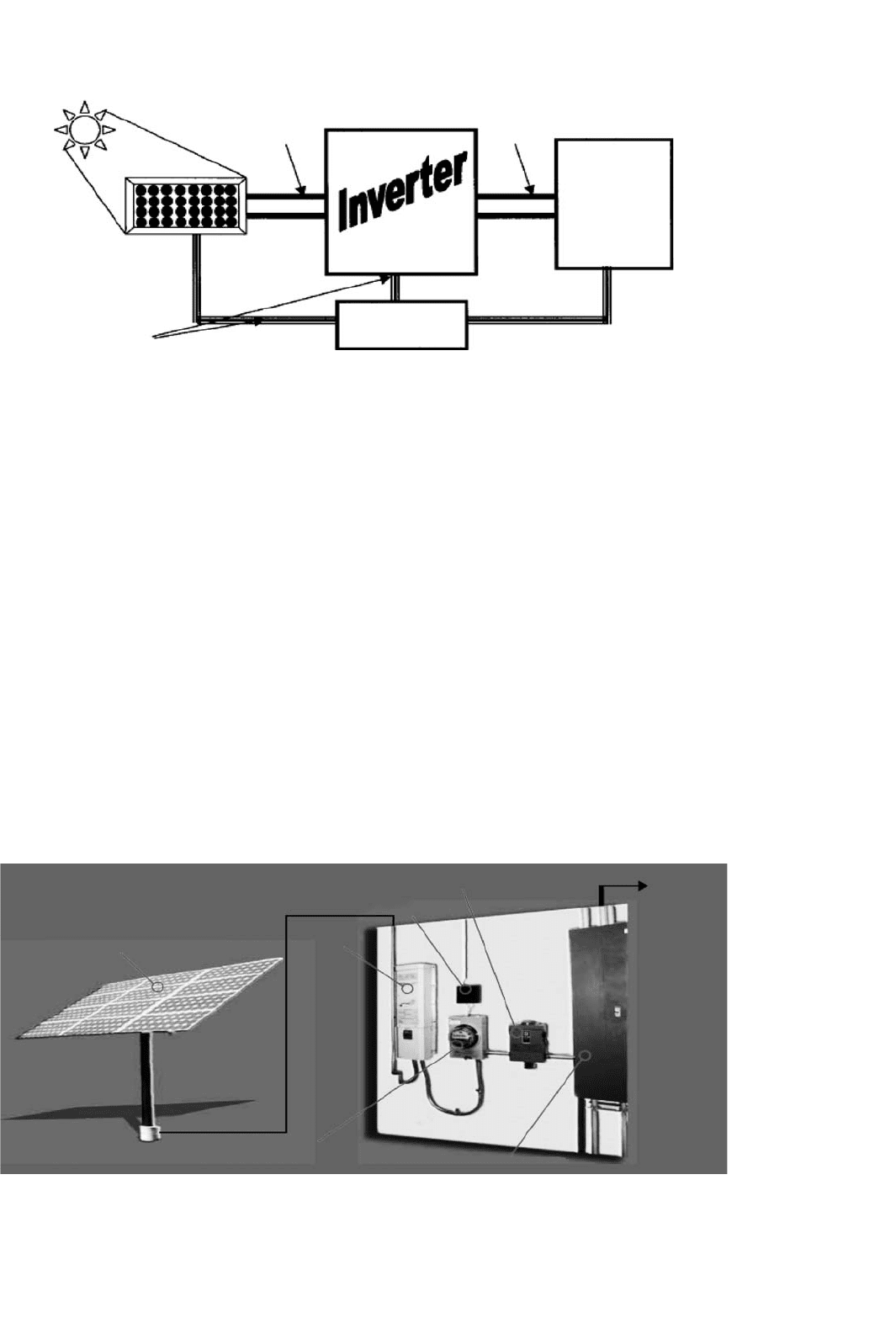
26 Solar Power Conversion 669
DC power
flow lines
Control
& sense
lines
AC power
flow lines
Utility
grid
Control
FIGURE 26.16 Diagram of grid-connected photovoltaic system [24].
inverter characteristics requirement are: operate over a wide
range of voltages and currents, regulate output voltage and
frequency, in addition to providing ac power with good power
quality. Several interconnection circuits have been described
in [25, 26].
For the last twenty years, researchers have been working on
developing different inverter topologies that satisfy the above
listed requirement. The evolution of solid state devices such
as MOSFETs, IGBTs, microprocessors, PWM integrated cir-
cuits have allowed improvements on the inverter. However,
more work is required to ensure quality control, reliability and
lower cost since these are the key for a sustainable photovoltaic
market.
A typical utility-interactive PV system is shown in Fig. 26.17
with metering to provide indication of system performance.
Photovoltaic array
Kilowatthour meter
Lockable AC disconnect
Data monitor
To
utility
grid
Inverter
Utility circuit breaker
FIGURE 26.17 Grid-connected PV system [23].
26.5.2 Stand-alone Photovoltaic Systems
Stand-alone photovoltaic systems are usually a utility power
substitute. They generally include solar charging modules,
storage batteries, and controls/regulator as shown in Fig. 26.18.
Ground or roof mounted systems will require a mounting
structure, and if 120/240 volt ac power is desired, a dc to
ac inverter will also be required. They are especially used in
remote places that are not connected to the electrical main
utility grid. In many stand-alone PV systems, batteries are
used for energy storage. A charge controller is then used to
control the whole system and prevent the battery from over-
charging and overdischarging. Photovoltaic modules charge
the battery during the day and supplies power to the load as
needed.

670 L. Chaar
PV array
Charge
controller
DC load
InverterBattery
AC load
FIGURE 26.18 Diagram of stand-alone PV system with battery storage
power dc and ac loads [6].
26.5.2.1 Batteries
Batteries are often used in PV systems for storing energy
produced by the PV array during day time and supplying
it to electrical loads as needed (during night time or cloudy
weather). Moreover, batteries are also needed in the tracker
systems to keep the operation at MPP in order to provide elec-
trical loads with stable voltages. Nearly, most of the batteries
used in PV systems are deep cycle lead-acid [27]. These bat-
teries have thicker lead plates that make them tolerate deep
discharges. The thicker the lead plates, the longer the life
span. The heavier the battery for a given group size, the
thicker the plates and the better the battery will tolerate deep
discharges [28].
All deep cycle batteries are rated in ampere-hour where
Ampere-hour (AH) capacity is a quantity of the amount of
usable energy it can store at nominal voltage. For example an
ampere-hour is one ampere for one hour or 10 A for one-tenth
of an hour and so forth [29]. A good charge rate is approxi-
mately 10% of the total capacity of the battery per hour (i.e.
200 ampere-hour battery charged at 20A). This will reduce
electrolyte loss and damage to the plates [28]. A PV system
may have to be sized to store a sufficient amount of power
in the batteries to meet power demand during several days of
cloudy weather. This is known as “days of autonomy”.
26.5.2.2 Charge Controller
The charge controller regulates the flow of electricity from
the PV modules to the battery and the load. The controller
keeps the battery fully charged without overcharging it. When
the load is drawing power, the controller allows charge to
flow from the modules into the battery, the load, or both.
When the controller senses that the battery is fully charged, it
stops the flow of charge from the modules. Many controllers
will also sense when loads have taken too much electricity
from batteries and will stop the flow until sufficient charge is
restored to the batteries. This last feature can greatly extend
the battery’s lifetime. However, controllers in stand-alone pho-
tovoltaic system are more complex devices that depend on
battery state-of-charge, which in turn depends on many fac-
tors and is difficult to measure. The controller must be sized
to handle the maximum current produced.
Several characteristics should be considered before selecting
a controller:
• Adjustable Setpoints.
•
High voltage disconnect.
• Low voltage disconnect.
• Temperature compensation.
• Low voltage warning.
• Reverse current protection.
The controller should ensure that no current flows from the
battery to the array at night.
26.6 Factors Affecting Output
PV systems produce power in proportion to the intensity of
sunlight striking the solar array surface. Thus there are some
factors that affect the overall output of the PV system.
26.6.1 Temperature
Output power of a PV system reduces as the module tempera-
ture increases. For Crystalline modules, a typical temperature
reduction factor recommended by CEC is 89% in the middle
of spring or a fall day, under full light conditions.
26.6.2 Dirt and Dust
Dirt and dust can accumulate on the solar module surface,
blocking some of the sunlight and reducing output. A typical
annual dust reduction factor to use is 93%. J. P. Thornton
showed that sand and dust can cause erosion of the PV surface
which affects the system’s running performance by decreasing
the output power to more than 10% [30].
26.6.3 DC–AC Conversion
Since the power from the PV array is converted back to ac as
shown previously, some power is being lost in the conversion
process, in addition to losses in the wiring. Common inverters
used have peak efficiencies of about 88–90%.
Thus a 100 Watts module under well controlled condi-
tions is actually a 95 Watts module under normal condition.

26 Solar Power Conversion 671
This power is then reduced due to the factors listed to:
Effect of Temperature: 95 × 0.89 = 85 Watts
Effect of Dirt and Dust: 85 ×0.93 = 79 Watts
Effect of Conversion: 79 × 0.90 = 71 Watts
26.7 System Design
The goal for a solar electric, or photovoltaic system is to
provide high-quality, reliable renewable electrical power.
26.7.1 Criteria for a Quality PV System
• Be properly sized and oriented to provide electrical power
and energy.
• Good control circuit to reduce electrical losses, overcur-
rent protection, switches and inverters.
• Good charge controller and battery management system,
should the system contain batteries.
26.7.2 Design Procedures
The first task in designing a PV system is to estimate the sys-
tem load. This is achieved by defining the power demand of
all loads, the number of hours of use per day, and operating
voltage [31].
From the load ampere-hours, and the given operating volt-
age for each load, the power demand is then calculated. For a
stand-alone system, the system voltage is the potential required
by the largest load. When ac loads dominate, the dc system
voltage should be chosen to be compatible with the inverter
input.
26.7.3 Power Conditioning System
The choice of the PCS has a great impact on the performance
and economics of the system. The choice of PCS depends on
the type of waveform produced which in turn depends on the
method used for conversion as well as the filtering techniques
of unwanted frequencies. Several factors must be considered
when selecting or designing the inverter [32]:
• The power conversion efficiency.
• Rated power.
•
Duty rating; the amount of time the inverter can supply
maximum load.
• Input voltage.
• Voltage regulation.
• Voltage protection.
• Frequency requirement.
• Power factor.
26.7.4 Battery Sizing
The amount of battery storage needed depends on the load
energy demand and on weather patterns at the site. There
is always a trade-off between keeping cost low and meeting
energy demand.
26.8 Summary
This chapter has discussed the conversion of solar energy into
electricity using photovoltaic system. There are two types of
PV systems: the grid-connected and the stand-alone. All major
components for such systems have been discussed. Maximum
power point tracking is the most important factor in PV sys-
tems to provide the maximum power. For this reason, several
tracking systems have been described and compared. Factors
affecting the output of such systems have been defined and
steps for a good and reliable design have been considered.
References
1. www.worldenergy.org/
2. Photovoltaics: Solar Electricity and Solar Cells in Theory and Practice
www.solarserver.de/wissen/photovoltaic-e.html
3. Moller H., Semiconductors for Solar Cells. London: Artech House,
Inc., 1993.
4. Berkeley Lab; http://www.lbl.gov/msd/pis/walukiewicz/02\
02_08_full_solar_spectrum.html
5. The Solar Sprint PV Panel http://chuck-wright.com/SolarSprintPV/
SolarSprintPV.html
6. EE362L, Power Electronics, Solar Power, I-V Characteristics,
Version October 14, 2005. http://www.ece.utexas.edu/∼grady/
EE362L_Solar.pdf
7. Photovoltaic Fundamentals http://www.fsec.ucf.edu/PVT/pvbasics/
index.htm
8. Serhan M. A., “Maximum Power Point Tracking system: An Adaptive
Algorithm for Solar Panels”, Thesis, American University of Beirut,
January 2005.
9. Johan H., Enslin R., Wolf M. S., Snyman. D. B., and
Swiegers W., “Integrated Photovoltaic Maximum Power Point
Tracking Converter”, IEEE Transactions on Industrial Electronics,
Vol. 44, No. 6, December 1997.
10. Hansen A., Sorensen P., Hansen L., and Bindner H., “Models for
a Stand Alone PV System”, Technical Report, Riso National Labo-
ratory, Roskilde, Norway, December 2000. http://www.solenergi.dk/
rapporter/sec-r-12.pdf
11. Kroutoulis E., Kalaitzakis K., and Voulgaris N.C., “Development of
a Microcontroller-Based, Photovoltaic Maximum Power Tracking
Control System”, IEEE Transactions on Power Electronics, Vol. 16,
No. 1, January 2001.
12. Hua C. and Shen C., “Comparative study of Peak Power track-
ing Techniques for Solar Storage System”, IEEE Applied Power
Electronics Conference and Exposition, Vol. 2, February 1998,
pp. 679–685.

672 L. Chaar
13. Hua C. and Lin J., “DSP-Based Controller in Battery Storage of
Photovoltaic System”, IEEE IECON 22nd International Conference
on Industrial Electronics, Control and Instrumentation, Vol. 3, 1996,
pp. 1705–1710.
14. Hussein K. H., Mutta I., Hoshino T., and Osakada M., “Maximum
photovoltaic power tracking: An algorithm for rapidly changing
atmospheric conditions”, IEE Proceedings, Generation, Transmis-
sion, and Distribution, Vol. 142, No. 1, January 1995.
15. Yu G., Jung Y., Choy I., Song J., and Kim G., “A novel two Mode
MPPT Control Algorithm Based on Comparative Study of Existing
Algorithms”, IEEE Photovoltaics Specialist Conference, May 2002,
pp. 1531–1534.
16. Shengyi Liu, “Maximum Power Point Tracker Model”, Control
model, University of South Carolina, May 2000, Available from:
http://vtb.engr.sc.edu/modellibrary_old
17. Tse K.K., Henry S. H., Chung, S. Y. R. Hui, and Ho M. T.,
“Novel Maximum Power Point Tracking Technique for PV Panels”,
IEEE Power Electronics Specialists Conference, Vol. 4, June 2001,
pp. 1970–1975.
18. Noguchi T., Togashi S., and Nakamoto R., “Short-Current Pulse-
Based Maximum Power Point Tracking Method for Multiple
Photovoltaic-and-Converter Module System”, IRRR Transactions on
Industrial Electronics, Vol. 49, No. 1, February 2002.
19. Lee D., Noh H., Hyun D., and Choy I., “ An Improved
MPPT Converter Using Current Compensation Method for Small
Scaled PV-Applications”, Applied Power Electronics Confer-
ence and Exposition (APEC’03), Vol. 1, February 2003,
pp. 540–545.
20. HowStuffworks http://science.howstuffworks.com/solar-cell5.htm
21. Masoum M., Dehbonei H., and Fuschs E., “Theoretical and
Experimental Analyses of Photovoltaic Systems with Voltage-and
Current-Based Maximum Power Point Tracking”, IEEE Transactions
Conversion, Vol. 17, No. 4, December 2002.
22. Hohm D. and Ropp M., “Comparative Study of Maximum Power
Point Tracking Algorithms Using an Experimental, Programmable,
Maximum Point Test Bed”, IEEE Photovoltaic Specialists Confer-
ence, September 2000, pp. 1699–1702.
23. DER Road Show, “Solar Photovoltaic Systems”, Overview
and Standards for permitting, Installations, Code Compliance,
and Inspections, http://www.eere.energy.gov/de/pdfs/road_shows/
arlington_pv.pdf
24. Bower W., “Inverters–Critical Photovoltaic Balance-of-system Com-
ponents: Status, Issues, and New-Millennium Opportunities”,
Progress in Photovoltaics: Research and Applications, Vol. 8, 2000,
pp. 113–126.
25. Mohan N., Undeland T., and Robbins W., Power Electronics:
Converter, Applications and Design, John Wiley and Sons, 3rd
edition.
26. Rashid M. H., Power Electronics: Circuits, Devices, and Applications,
Prentice Hall.
27. Enslin J. and Snyman D., “Combined Low Cost, High Efficient
Inverter, Peak Power Tracker and Regulator for PV Applications”,
IEEE Transactions on Power Electronics, Vol. 6, No. 1, January 1991.
28. Linden D., Handbook of Batteries, New York: McGraw Hill, 1995.
29. Jian W., Jianzheng L., and Zhengming Z., “ Optimal Control of Solar
Energy Combined with MPPT and Battery Charging”, Proceedings of
IEEE International Conference on Electrical Machines and Systems,
Vol. 1, November 2003, pp. 285–288.
30. Thornton J. P., “The Effect of Sand-Storm on Photovoltaic Array and
Components”, Solar energy Conference, 1992.
31. Sandia National Laboratories: Stand-Alone Photovoltaic Systems”
A Handbook of Recommended Design Practices, National Technical
Information Service, Springfield, VA, 1988.
32. Wolete J. N., “An interactive Menu-Driven Design Tool for Stand-
Alone Photovoltaic Systems”, Thesis, Virginia Polytechnic Institute.
http://scholar.lib.vt.edu/theses/public/etd-11698-16389/materials

27
Power Electronics for Renewable
Energy Sources
C. V. Nayar, S. M. Islam,
H. Dehbonei, and K. Tan
Department of Electrical and
Computer Engineering, Curtin
University of Technology, GPO
Box U1987, Perth, Western
Australia 6845, Australia
H. Sharma
Research Institute for Sustainable
Energy, Murdoch University,
Perth, Western Australia,
Australia
27.1 Introduction .......................................................................................... 673
27.2 Power Electronics for Photovoltaic Power Systems........................................ 674
27.2.1 Basics of Photovoltaics • 27.2.2 Types of PV Power Systems • 27.2.3 Stand-alone
PV Systems • 27.2.4 Hybrid Energy Systems • 27.2.5 Grid-connected PV Systems
27.3 Power Electronics for Wind Power Systems ................................................. 700
27.3.1 Basics of Wind Power • 27.3.2 Types of Wind Power Systems • 27.3.3 Stand-alone Wind
Power Systems • 27.3.4 Wind–diesel Hybrid Systems • 27.3.5 Grid-connected Wind
Energy Systems • 27.3.6 Control of Wind Turbines
References ............................................................................................. 714
27.1 Introduction
The Kyoto agreement on global reduction of greenhouse gas
emissions has prompted renewed interest in renewable energy
systems worldwide. Many renewable energy technologies today
are well developed, reliable, and cost competitive with the
conventional fuel generators. The cost of renewable energy
technologies is on a falling trend and is expected to fall fur-
ther as demand and production increases. There are many
renewable energy sources (RES) such as biomass, solar, wind,
mini hydro and tidal power. However, solar and wind energy
systems make use of advanced power electronics technolo-
gies and, therefore the focus in this chapter will be on solar
photovoltaic and wind power.
One of the advantages offered by (RES) is their poten-
tial to provide sustainable electricity in areas not served by
the conventional power grid. The growing market for renew-
able energy technologies has resulted in a rapid growth in the
need of power electronics. Most of the renewable energy tech-
nologies produce DC power and hence power electronics and
control equipment are required to convert the DC into AC
power.
Inverters are used to convert DC to AC. There are two
types of inverters: (a) stand-alone or (b) grid-connected. Both
types have several similarities but are different in terms of
control functions. A stand-alone inverter is used in off-grid
applications with battery storage. With back-up diesel genera-
tors (such as photovoltaic (PV)/diesel/hybrid power systems),
the inverters may have additional control functions such as
operating in parallel with diesel generators and bi-directional
operation (battery charging and inverting). Grid interactive
inverters must follow the voltage and frequency characteristics
of the utility generated power presented on the distribution
line. For both types of inverters, the conversion efficiency is a
very important consideration. Details of stand-alone and grid-
connected inverters for PV and wind applications are discussed
in this chapter.
Section 27.2 covers stand-alone PV system applications such
as battery charging and water pumping for remote areas.
This section also discusses power electronic converters suit-
able for PV-diesel hybrid systems and grid-connected PV
for rooftop and large-scale applications. Of all the renewable
energy options, the wind turbine technology is maturing very
fast. A marked rise in installed wind power capacity has been
noticed worldwide in the last decade. Per unit generation cost
of wind power is now quite comparable with the conventional
generation. Wind turbine generators are used in stand-alone
battery charging applications, in combination with fossil fuel
generators as part of hybrid systems and as grid-connected sys-
tems. As a result of advancements in blade design, generators,
power electronics, and control systems, it has been possible to
increase dramatically the availability of large-scale wind power.
Copyright © 2007, 2001, Elsevier Inc.
All rights reserved.
673
